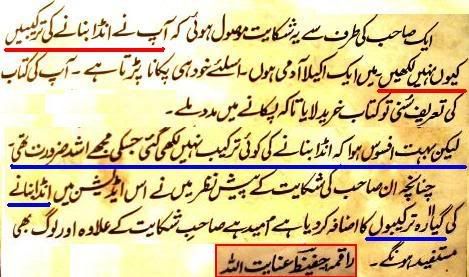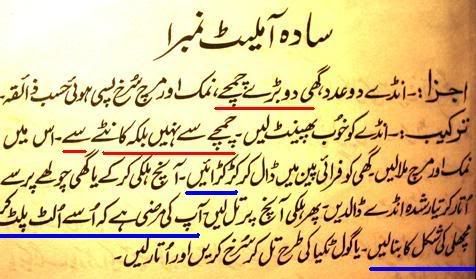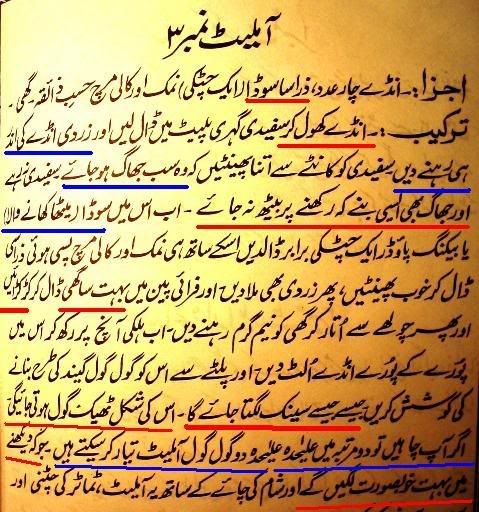We proudly own a copy of Hafeez Inayatullah‘s famous book ‘khaana pakaana’ (cooking meals). At first we thought the book was written by a male author named Mr Hafeez, but after reading the preface it dawned on us that author is infact a lady named Ms Hafeez, because she wrote the word ‘raqma‘(female writer) before her name.
After first edition of the book was published, a dejected single male complained to Ms Hafeez that her book doesn’t tell him how to cook eggs. Ms Hafeez immediately paid heed to this important need of single population and 2nd edition of the book now contains 11 priceless recipes on how to cook eggs. Below is an excerpt from the preface where Ms Hafeez explains the reasons of including egg recipes.

The book is great. It is an encyclopedia of recipes. There are 19 recipes of cooking chicken, 17 for rice dishes, 33 for ‘qeema’ (minced meat), 31 for regular meat, 26 for fish and the list goes on and on.
(1) Simple Omelet Number One:
To conserve space and to keep our readership’s suspense intact I’ll share with you only 2 out of 11 egg recipes. The first one is titled: ‘Simple Omelet Number One’. Points to be noted are underlined in Urdu text below. Ingredients include 2 big spoons full of oil. To beat the egg into omelet, author is instructing us to use a fork instead of a spoon. She has also used a word ‘kaR-kaR-aayeN’ which I’ve never heard in Urdu before. It means the oil needs to be heated until it starts sounding like ‘kaR kaR aayeN aayeN’ or just ‘kaR kaR kaR kaR’. This is such a phoenitc invention of a word that I must say this book not only caters to ones stomach needs but also to linguistic thirst. In the last line author gives us a choice to make this omelet in the shape of a fish by flip-flopping it continuously. Now this must be something special. I’ve never eaten an omelet shaped like a fish before. Enjoy :) 
(2) Omelet Number Three:
The recipe’ below is titled as ‘Omelet Number Three’. Ingredients include a little bit of Soda, besides the 4 eggs needed for this type of omelet i.e. the Omelet number three. Under recipe’ instructions, the author asks us to ‘Open the eggs’. Don’t break them ok. Just carefully open them. Drain the white material into a plate but make sure to keep the yolk inside the opened eggs. Now beat the egg-white so much that it turns into foam. Make sure the foam is not temporary. It should remain in foam texture even after the beating is stopped. Now add Soda (the one that is suitable to eat. none other please) to it and blah blah blah. The word ‘kaR-kaR-aayeN’ is used in this recipe’ also. The last couple of lines instruct us to try to make this omelet round as a ball and use low heat. As the heat will start going into the egg it will start getting rounder and rounder. If you want you can make 2 separate round omeletes by repeating the same recipe’ 2 times. The last line reads that the resulting omelet will look very beautiful.
Please feel free to share with us anyother great egg recipes that you may know.





















































Owais, when I was at UET Lahore, we used two have these two dishes that we got at the hostel that you may not find in this recipe book.
The first was ‘Aalo Unda’. It comes in various variants all over Pakistan and has various names but the UET version was in a class of its own. The key thing, of course, was that it was more Aalo than Unda.
Second, was ‘Daal Omlette’. Essentially stale omlete from the breakfast floating in staler Daal from the previous night. It was wonderful, always ran out quick.
When I was a student the omelette was my favorite thing to cook. My recipe was simpler. Break as many eggs as you can find, put in all masallas you seen, add anything else lying around that looks interesting, beat, and then … as the lady says … KaR-kaR-aayeN!
LOL : ‘kaR-kaR-aayeN’
So, THAT is what ‘Raqma’ means…. never knew that… I guess blogging is educational after all ;-) Thanks.
I wish I had the book as a guide at university. It would have definitely saved a lot of disasters in the kitchen. Now remembering my escapades in the kitchen and laughing.